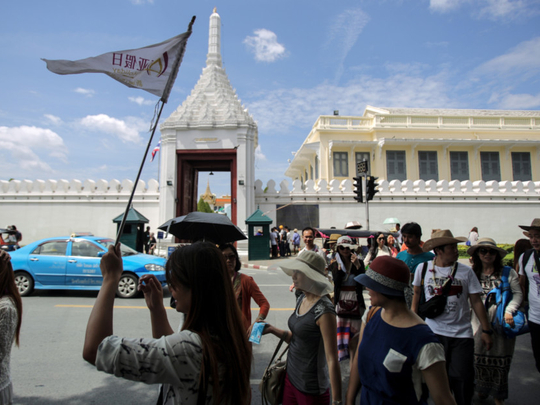
Thailand — land of golden temples, white-sand beaches, smiling hosts. Or of overcrowded airports, epic traffic jams and littered seashores.
Facing a deluge of Chinese tourists that has strained its airports beyond capacity, the Southeast Asian nation is spending billions to upgrade its infrastructure, open up new islands and cities to travellers, and tone down its image of cheap shopping, hotels and sex that underpinned the industry for half a century. But the change will take years and even then may fail to keep up with soaring visitor numbers that have given the Land of Smiles a reputation for delays, overcrowding and government crackdowns.
“Our strategy was more for less, not less for more, so we invited a lot of tourists from China,” said Suvit Maesincee, in an interview last month, when he was the minister attached to the Prime Minister’s office. “I think in the near future we need to change from volume to value.”
The military-backed government relies on tourism for 18 per cent of the economy and foreign inflows have made the baht one of the strongest performers in Asia this year, a bright spot amid weak domestic consumer demand and private investment. While it plans to spend more than $5 billion to double capacity at its international airports, it’s planning to increase foreign tourist numbers at a similar pace, reaching 68 million in the next decade.
Weerasak Kowsurat, who returned to the post of tourism minister in November in a cabinet reshuffle by the military government, is frank about the challenge: “Today we’re not even ready,” he said. “To get us prepared within a year is not even possible.”
At the heart of the upgrade, and the congestion, are Bangkok’s two international airports: Suvarnabhumi and Don Mueang, which are running at 40 per cent beyond designed capacity. New terminals, facilities and another runway would allow them to handle 130 million passengers a year, including inbound and outbound trips.
But work won’t be completed until 2022 at the earliest, and the first taste most travellers get of the Thai capital is a long queue at immigration.
“In three to five years time we might not reach our targeted tourist growth due to a lack of airport capacity,” said Thongyoo Suphavittayakorn, a spokesman for the Association of Thai Travel Agents. “The problem with the Thai government is they want to increase the number of visitors but they don’t stop to check first if we’re able to accommodate” them.
Once out of the terminal building, visitors must contend with the Bangkok traffic, the world’s most congested after Mexico City, according to TomTom NV’s traffic index.
“We took five hours to go to the hotel just because of the traffic,” said Diogo Matos, a first-time visitor from Portugal. “It was a horrible start to our trip.”
Thailand’s ability to attract tourists has defied the effects of a military coup, floods, political protests, a tsunami, airport blockades and the global financial crisis. In the past 15 years, more visitors have arrived from Europe, North America, Japan and Southeast Asia. But it is the explosion in Chinese visitors since the 2012 Chinese road movie “Lost in Thailand” that has changed the industry.
The number of Chinese visitors to Thailand has tripled in the past five years, to 8.8 million in 2016. They account for more than a quarter of all foreign tourists and 28 per cent of revenue, according to official data.
The sudden influx, boosted by packaged tours arranged in China, led to accusations of so-called zero-dollar tourism, where groups were shepherded through shopping and sightseeing itineraries that provided little benefit to the host country.
A clampdown last year on those tours — 29 operators were prosecuted — caused a temporary dip in Chinese arrivals, but the tour numbers soon rebounded, and the number of independent travellers from China, making their way around the country with the help of their smartphones and Google Translate, continues to rise.
Meanwhile, the government is making efforts to clean up the country’s image. Former Tourism Minister Kobkarn Wattanavrangkul, who was replaced in the cabinet reshuffle, began a crackdown on sex tourism last year, with police and army officials raiding bars and hostels in Pattaya’s red-light district.
On the island of Phuket, attempts have been made to clear away the beach touts and reduce littering. In October, the government extended a ban on trips to the nearby Koh Khai islands, because of damage to the coral reef from speedboats that brought thousands of day-trippers. Last month, 21 beaches in popular spots like Pattaya and Krabi instituted a smoking ban.
“They want to shift the emphasis away from quantity and towards the quality of tourists coming,” said Patrick Cooke, an editor in Manila for Oxford Business Group Ltd. “To do that, obviously more investment is required in the luxury segment and the wellness segment.”
One plan includes a Japanese-backed $15 billion double-rail link from the capital to Chiang Mai in the north that would open up cities and towns along its route. Another is to build a new regional airport in the south at Betong. Phuket opened a new international terminal last year, looking to become a gateway for surrounding regions like Phang Nga and Krabi.
In addition, the government is revamping the old U-Tapao navy airbase near Pattaya, from which US B-52s flew to bomb Vietnam in the 1960s. A Chinese-funded high-speed rail link would connect the beach resort with Bangkok’s airports, 150 kilometres to the north.
“What they’re doing is adding more spots to see, while not taking care to preserve the old spots that are becoming worn out,” said Puttachard Lunkam, a tourism analyst at Krungsri Research in Bangkok. “You see islands being closed or national reservations being barred to tourists as a way to fix things when it’s gone too far, but not enough is being done to maintain the sites before it gets to that point.”
There are some signs that the more-from-less strategy may be having an effect. Revenue from tourism in the first 10 months of this year increased by about 9 per cent, outpacing a 6.4 per cent growth in visitor numbers, according to data from the Thailand Department of Tourism.
But extracting more profit from visitors won’t be easy. Thailand is already one of the world’s top destinations for medical tourism, and high-end resorts have nestled in its secluded bays and picturesque forests for decades. Ultra-luxury chain Aman Resorts International began life in Phuket in 1988 and Four Seasons Holdings Inc opened its first-ever boutique resort in Chiang Rai in 2005.
And other countries in the region are also trying to emulate Thailand’s success in turning Chinese leisure into loot. Indonesian President Joko Widodo plans to create “10 new Balis”, to try to replicate the success of the Island of the Gods, which hosts more than 40 per cent of the 11.6 million visitors to the country. Malaysia is investing billions in opening up its eastern coast, including building a railway to the capital.











